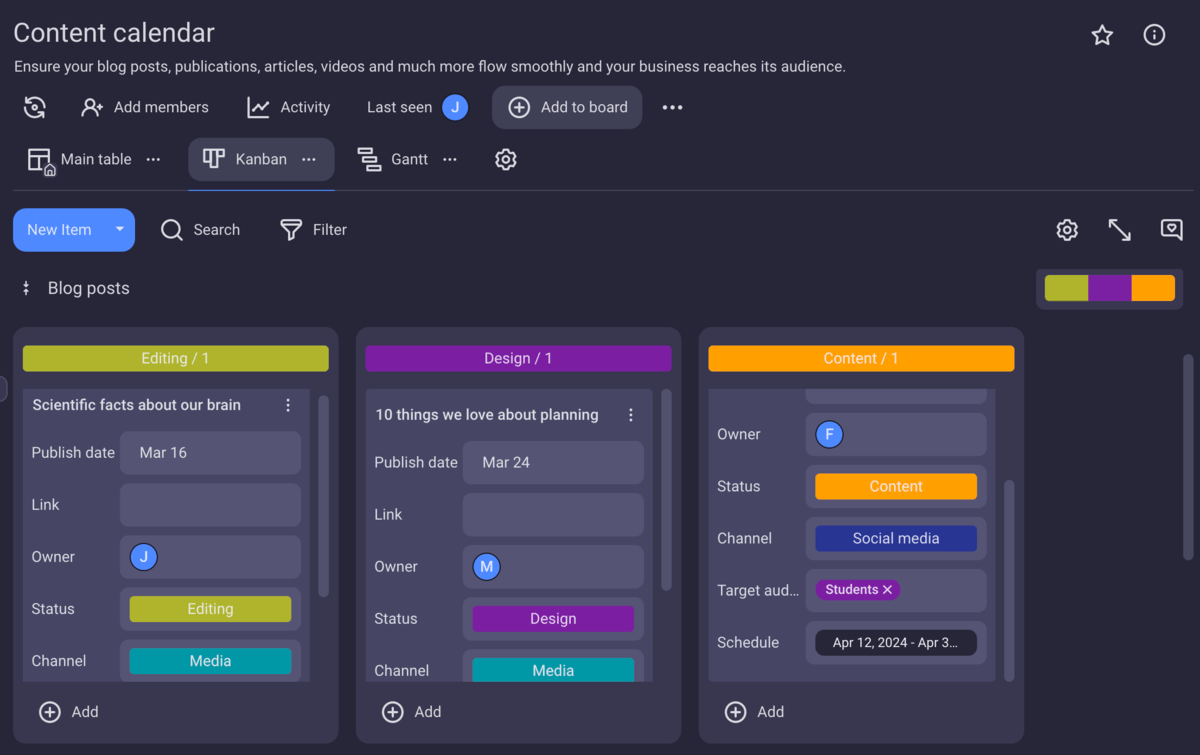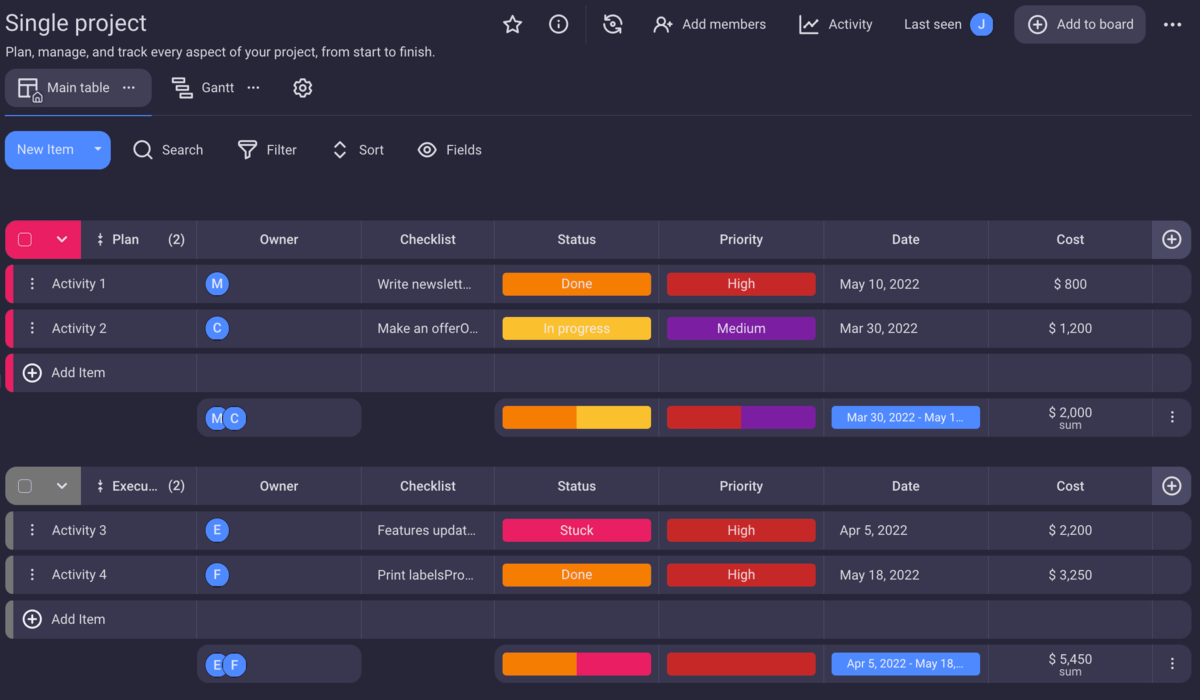Project integration management is the first of ten knowledge areas in the Project Management Body of Knowledge (PMBOK).
It outlines the processes by which you can integrate project management at every stage of a project’s life cycle to give it the best chance of success.
This helps projects stay on track and keeps them aligned with the organization’s long-term goals and objectives.
In this article, we’ll cover:
- What the 7 processes of project management integration are,
- Why project integration management is important, and
- How to facilitate project integration management at your organization.

In this article:
What is project integration management?
Project integration management involves identifying, combining, and coordinating the various activities and processes within a project so that they lead to achieving the project objectives in the most efficient way.
It looks at all the elements of a project — such as resources, tasks, and deliverables — and makes sure they interact in the most seamless way possible toward project success.
The integration process is an intricate balancing act in a way, as it involves a lot of weighing and measuring, which often results in difficult decisions and trade-offs.
For example, integration management steps in when you have to decide whether to go over budget or schedule to meet stakeholder needs. It may also include reallocating resources, e.g. members of a team working on nice-to-have features of a product are re-assigned to help with the main features, saving the nice-to-haves for further releases.
The 7 processes of project integration management
To ensure that you are utilizing the project integration management knowledge area effectively, you need to follow these 7 processes:
- Develop project charter,
- Develop project management plan,
- Direct and manage project work,
- Manage project knowledge,
- Monitor and control project work,
- Perform integrated change control, and
- Close project or phase.
These 7 processes should not be confused with the 5 stages of project management, as several of the processes (along with many other chapters in PMBOK) can be part of a single stage.
Here’s how they compare:
| The 5 stages of project management | The 7 processes of project integration management |
|---|---|
| Initiation | Develop a project charter |
| Planning | Develop a project management plan |
| Execution | Direct and manage project workManage project knowledge |
| Monitoring | Monitor and control project workPerform integrated change control |
| Closure | Close project or phase |
Process #1: Develop a project charter
First things first, an integrated project needs to have a project charter.
You can think of this as the project’s birth certificate, which formally acknowledges its existence.
The project charter gives you a top-down overview of the project and its contains some or all of the following info:
- Project title,
- General project information,
- Project goal,
- Project scope,
- Project deliverables,
- Project resources,
- Project milestones,
- Project risks,
- Key stakeholders,
- Success metrics, and
- Project approval.
It’s like an elevator pitch for the project.
Moreover, the project charter formally authorizes the project manager to use the organization’s resources for the sake of the project.
Projects without a project charter quickly run into issues due to lack of stakeholder buy-in.
With a project charter, you can ensure that the organization is committed to the project and avoid such hiccups down the line.
In case you’re preparing to get a project management certification — and especially if it’s for the Project Management Professional exam — you should also keep in mind that the project charter is an agreement rather than a contract, as its creation is not accompanied by any monetary exchange.

Download project charter template
Process #2: Develop a project management plan
Step two in managing integrated projects is developing a project management plan (PMP).
This marks our venture into the planning stage of the project.
A PMP isn’t a single document. Rather, it is a collection of all documents pertaining to project planning.
These are some of the documents that comprise the PMP:
- A scope management plan,
- A requirements management plan,
- A schedule management plan,
- A cost management plan,
- A resource management plan,
- A quality management plan,
- A communications management plan,
- A risk management plan,
- A procurement management plan, and
- A stakeholder engagement plan.
You can find templates for all the PMP documents listed above in our detailed project management plan guide.
During this step, you will establish the scope, cost, and schedule baseline, with the baseline being a reference point against which the project is monitored.
Each bullet point in this list is also composed of several documents and/or activities.
For example, you’ll create a Work Breakdown Structure (WBS) as part of the scope management plan. This WBS will then be used to create the project schedule. For this, you will need to estimate activity durations and sequence activities using a project scheduling algorithm like the Critical Path Method or Critical Chain Project Management.
All of this is to say that a project plan is a crucial part of project integration management and one that should be done before project execution.
However, creating a PMP is also an iterative process. This plan can and should be updated regularly to reflect project changes — but more on that in step six.
Even Agile projects need a PMP. It doesn’t have to be detailed, but it should still be made. Working without even a summary-level PMP greatly reduces the chances of project success.

Process #3: Direct and manage project work
Step three comprises most of the nitty-gritty when it comes to project integration management.
This is the execution step, where the project team goes about creating the project deliverables.
In other words, once you’ve made the plan, you need to make it happen.
In most cases, you won’t be able to follow the plan 100% of the time — corrective actions, repairs, and delays can put a damper on the plan and necessitate the implementation of approved changes. Should these changes affect the scope, budget, or any other part of the project plan, you should update the plan to reflect this.
The ways in which you can direct and manage project work are vast and varied.
Most project managers use one of the many project management methodologies to guide their efforts.
Which methodology you should use will depend on your preferences as a project manager and the needs of the project.
While there are many different methodologies, we can roughly divide them into two categories:
- Predictive, and
- Iterative.
Predictive methodologies like Waterfall work wonders in construction and manufacturing, where the margin for error is slim and backtracking is either impossible or highly impractical. For reference, when constructing a building, deciding to increase the square footage of floor five after the walls and roof have already been made would either be impossible or highly impractical.
Iterative methodologies like Kanban, Scrum, Scrumban, or any of the other Agile frameworks, embrace the idea of continuous improvement throughout the project lifecycle. Without a skilled project manager and project integration management, these projects can quickly succumb to scope creep. Project integration management helps you keep the benefits of iteration without allowing the scope to balloon out of proportion.
Regardless of which methodology you opt for, you should collect work performance data to keep track of project performance.

Process #4: Manage project knowledge
Step four of project integration management is managing project knowledge.
This includes creating new knowledge and using previously obtained knowledge to benefit the project. Any knowledge obtained during the lifecycle of a project should be added into a lessons learned repository, from where they can be accessed as previously obtained knowledge for subsequent projects.
In this context, a piece of knowledge could be the project schedule with all the activities and dates listed and available for the project team to see.
PMBOK splits knowledge into two types:
- Explicit knowledge — knowledge that is easy to convey using words, numbers, graphs, etc.
- Tacit knowledge — knowledge that is difficult to convey, as it stems from experience or insight.
The point of managing project knowledge is to ensure that the skills and knowledge of project team members are properly utilized throughout the project lifecycle.
Process #5: Monitor and control project work
Step five of project integration management is monitoring and controlling project work.
To put it bluntly, this step is all about keeping tabs on whether or not project execution is aligned with the project plan.
While monitoring and controlling project work, you’ll regularly have to:
- Validate scope,
- Control scope,
- Control schedule,
- Control costs,
- Control quality,
- Control resources,
- Monitor communication,
- Monitor risks, and
- Monitor stakeholder engagement.
Actions taken during this step will inevitably lead to changes or updates to the project management plan developed in step two.
These changes should be documented so that the PMP always reflects the state of the project in real time.
Monitoring and controlling project work can help predict the current trajectory of the project and inform changes that need to be made to keep this trajectory as it should be.

Process #6: Perform integrated change control
Step six of project integration management is performing integrated change control.
Basically, while monitoring and controlling project work, you may find that some baseline documents require certain changes — we’re talking about making changes to scope, cost, or schedule.
Changes to any of these project elements cannot be made just like that.
Integrated change control is used to ensure that these changes follow proper procedures before their effects can impact the project.
Managing, reviewing, and approving changes to deliverables, documents, or the PMP all constitute integrated change control.
From the point when baselines are established, all changes need to be formally controlled in this way. This is because all changes have the potential to affect scope, schedule, quality, or cost, thereby throwing the accuracy of the PMP out the window.
Process #7: Close project or phase
Step seven of project integration management helps project managers finalize the project or phases (milestones).
Milestones are used in all projects, but they’re particularly important in Agile projects, where adding a new feature often needs to be treated as a mini-project in and of itself.
First things first, the project manager needs to go through the PMP to check whether all project work was completed.
Then, once the final deliverable is delivered, the project manager needs to update the project documentation and write an overall project evaluation report.
In addition to this, most project managers also conduct a post-mortem report of the team.
Aside from completing the current project, these reports also serve the purpose of providing insights for any future projects.
Lastly, we should mention that the project manager is in charge of everything outlined in these seven steps — these tasks cannot be delegated.
Why is project integration management important?
Now we know what project integration management entails, but why should we bother?
Why is this important?
Here’s the thing: in today’s business world, the word project gets thrown around a lot.
Naturally, this means that the understanding of project management has also become amorphous to an extent.
In many cases, project managers don’t follow all steps required for effective project management. Instead, managing a project often devolves into simple task management.
The most recent project management statistics support this, leading to the following figures:
- 34% of project managers don’t use risk management.
- 42% of project managers don’t follow any formal methodology.
- 52% of projects have a scoping document.
The key word in project integration management is integration.
Integrating projects means utilizing all standardized practices described in PMBOK to ensure that your projects have the best chance of success and don’t omit any crucial procedures.
In a sentence, project integration management is important because it increases the chances of project success.
How to facilitate project integration management at your organization?
The seven steps covered by project integration management included a lot of information, even in this abridged form of a quick guide.
Not only is this a lot for the project manager to keep tabs on — it gets downright impossible for other stakeholders who aren’t as concerned with the top-down view of the overall project.
To ensure that everyone is staying on track and benefiting from project integration management, use of a project management tool like Plaky is a must.
Plaky allows you to centralize all your project management needs by providing access to:
- Unlimited boards,
- Unlimited users, and
- Unlimited tasks.
Couple this with the extensive customization features, and your organization will have a centralized platform for:
- Storing and updating documentation,
- Managing workflows, and
- Monitoring progress.

Conclusion: Project integration management is just project management done right
The meaning of words and phrases is not set in stone.
Until the mid-1800s, dinner used to refer to the midday meal — what we now call lunch.
Today, lunch is the midday meal and dinner is the evening meal.
You can be unhappy with this change, but running contrary to it will only invite misunderstandings — you can’t reasonably expect to invite someone to dinner and get frustrated when they don’t show up at noon.
Something similar happened to the term project management.
Somewhere along the line, we started calling everything a project while management devolved to execution.
For all the complications and confusing terminology, understanding what project integration management is should be very simple.
Project integration management is basically just project management done by the book — it is what you get when you take all the knowledge areas related to project management and actually apply them.

